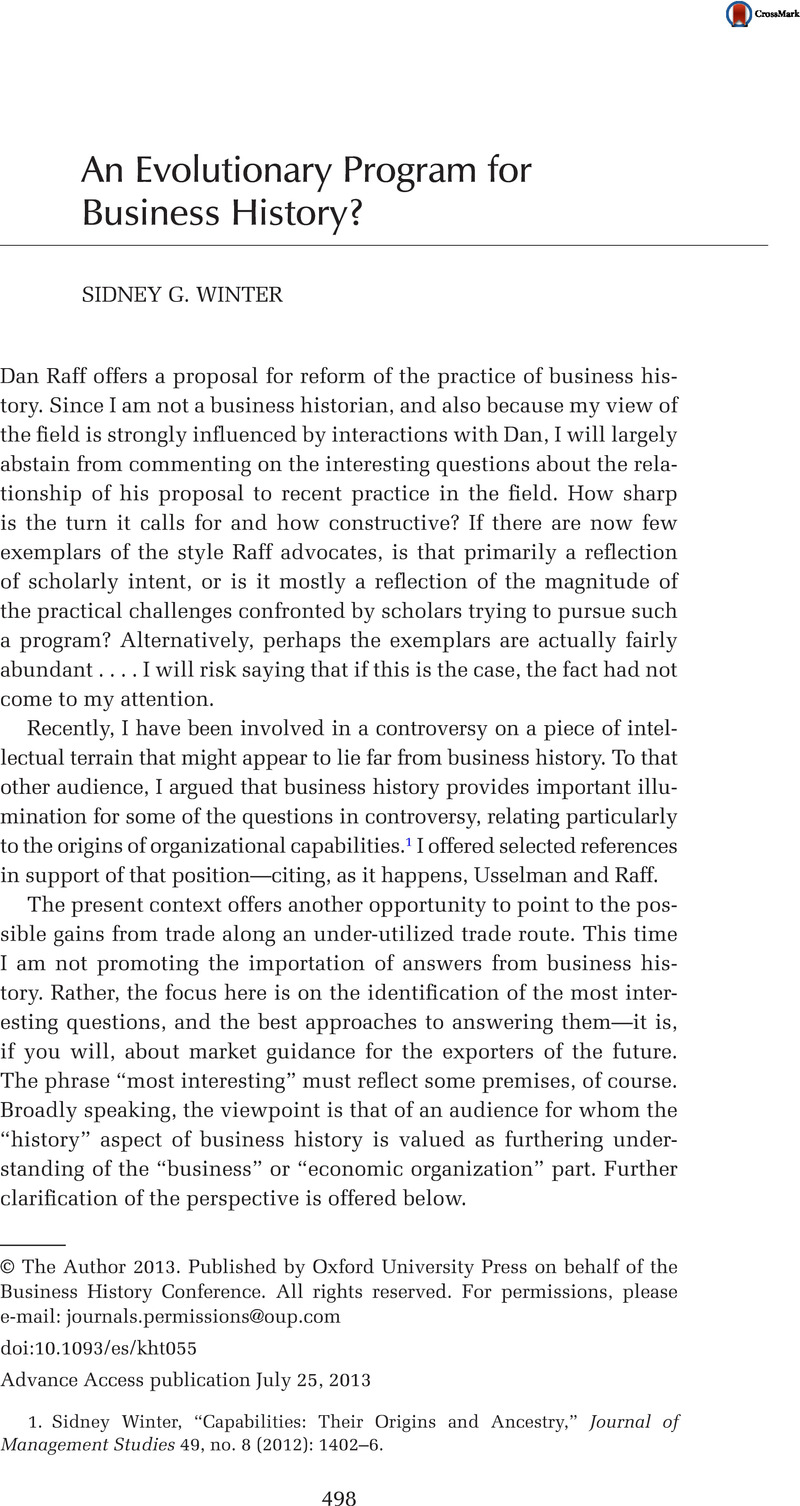Article contents
An Evolutionary Program for Business History?
Published online by Cambridge University Press: 18 February 2015
Abstract

- Type
- Manuscript
- Information
- Copyright
- Copyright © The Author(s) 2013. Published by Cambridge University Press on behalf of the Business History Conference. All rights reserved.
References
1. Winter, Sidney, “Capabilities: Their Origins and Ancestry,” Journal of Management Studies 49, no. 8 (2012): 1402–6.CrossRefGoogle Scholar
2. This sketch complements Raff’s own characterizations of my work with Nelson, attending more to the background of premises and motivations that we share with a large number of colleagues who pursue the evolutionary vision in economics. Implicitly, it presents fundamental contrasts to mainstream thinking in the discipline.
3. Marshall, Alfred, Principles of Economics, 8th ed., New York: Macmillan, 1.Google Scholar
4. Veblen, Thorstein, “Why is Economics Not an Evolutionary Science?” Quarterly Journal of Economics 12, no. 3 (1898): 373–97.CrossRefGoogle Scholar
5. Kahnemann, Daniel, Thinking, Fast and Slow, New York: Farrar, Straus and Giroux, 2011 Google Scholar, esp. ch. 19.
6. Ibid; 85–88.
7. Raff, Daniel, “How to Do Things,” Enterprise & Society 14, no. 3: : 435–66CrossRefGoogle Scholar, quote from 459.
8. Utterback, James M. and Abernathy, William J., “A Dynamic Model of Process and Product Innovation,” Omega 3, no. 6 (1975): 639–56.CrossRefGoogle Scholar
9. My own work has included participation in modeling efforts directed to some of these issues. The computer industry study initially presented in Malerba, Franco, Nelson, Richard, Orsenigo, Luigi, and Winter, Sidney, “History-Friendly Models of Industry Evolution: The Computer Industry,” Industrial and Corporate Change 8, no. 1 (1999): 1–36 CrossRefGoogle Scholar, will appear in revised form as a chapter in Malerba, Franco, Nelson, Richard, Orsenigo, Luigi, and Winter, Sidney G., Innovation and the Evolution of Industries: History Friendly Models, Cambridge, UK: Cambridge University Press Google Scholar, forthcoming. The “History Friendly” work is particularly relevant here because it includes exploration of the *counter-factual history of a real phenomenon—which is much less problematic in a simulation model than for the real thing. On entrepreneurial choices about vertical scope and financing, see Jacobides, Michael G. and Winter, Sidney G., “Entrepreneurship and Firm Boundaries: The Theory of A Firm,” Journal of Management Studies 44 (2007): 1213–41.CrossRefGoogle Scholar
10. As Berra subsequently explained in a book of this title, the instruction was adequate in context because his home was on a circle and either turn would get you there.
11. Raff, “How to Do Things,” 450.
12. For more extensive discussion of this point, see Jacobides, Michael G. and Winter, Sidney G., “Capabilities: Structure Agency and Evolution,” Organization Science 23 (2012): 1365–81CrossRefGoogle Scholar, sec. 4.1. As is slyly remarked there, “The problem with formal rationality is that it ignores some very powerful incentives that operate in firms and sectors” (1373).
13. There are interesting, citable examples under each of the three headings mentioned here, but space constraints preclude a substantial annotation. One of several candidates under the second heading is Polaroid’s encounter with digital imaging technology; see Tripsas, Mary and Gavetti, Giovanni, “Capabilities, Cognition, and Inertia: Evidence from Digital Imaging,” Strategic Management Journal 21, no. 10 (2000): 1147–61.3.0.CO;2-R>CrossRefGoogle Scholar
14. That instrumental relation is very much part of what Nelson and I had in mind. See our discussion of the third of our three questions directed to the “contemporary orthodoxy” of production sets: “How does the knowledge possessed by one firm relate to that of others and to the knowledge environment generally?” ( Nelson, Richard R. and Winter, Sidney G., An Evolutionary Theory of Economic Change, Cambridge, MA: Harvard University Press, 1982, 64–65.Google Scholar).
15. Raff, “How to Do Things,” 436.
- 7
- Cited by


